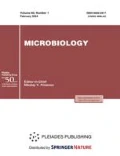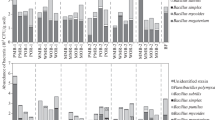Abstract
Dynamics of the taxonomic structure of epiphytic bacterial communities of the rhizosphere and phyllosphere of seven weed species was studied. The major types of isolated organisms were identified using phenotypic and molecular biological approaches. Dispersion analysis revealed that the ontogenesis stage and plant organ were the factors with the greatest effect on the taxonomic structure of the communities. The dominant microorganisms of weeds were similar to those of cultivated plants. The minor components revealed in the spectra of bacterial communities of weeds belonged to poorly studied genera of chemolithotrophic proteobacteria.
Similar content being viewed by others
References
Bergey’s Manual of Systematic Bacteriology, vols. 1–2, Holt, J.G., Ed., Baltimore: Williams and Wilkins, 1986.
Bodenhausen, N., Horton, M.W., and Bergelson J., Bacterial communities associated with the leaves and the roots of Arabidopsis thaliana, PLoS One, 2013, vol. 8, no. 2, pp. 1–9.
Dobrovol’skaya, T.G., Khusnetdinova, K.A., Manucharova, N.A., and Balabko, P.N., The structure and functions of bacterial communities in an agrocenosis, Euras. Soil Sci., 2016, vol. 49, no. 1, pp. 70–76.
Edwards, U., Rogall, T., Bloeker, H., Ende, M.D., and Boeettge, E.C., Isolation and direct complete nucleotide determination of entire genes, characterization of gene coding for 16S ribosomal RNA, Nucl. Acids Res., 1989, vol. 17, pp. 7843–7853.
Gibello, A., Vela, A.I., Martin, M., Bara-Caracciiolo, A., Grenni, P., and Fernangez-Garayzarball, J.F., Reclassification of the members of the genus Tetrathiobacter Ghosh et al. 2005 to the genus Advenella Coenye et al. 2005, Int. J. Syst. Evol. Microbiol., 2009, vol. 59, pp. 1914–1918.
Kremer, R.J., Begonia, M.F.T., Stanley, L., and Lanham, E.T., Characterization of rhizobacteria associated with weed seedlings, Appl. Environ. Microbiol., 1990, vol. 56, pp. 1649–1655.
Lysak, L.V., Dobrovol’skaya, T.G., and Skvortsova, I.N., Metody otsenki bakterial’nogo raznoobraziya pochv i identifikatsii pochvennykh bakterii (Methods for Assessment of Soil Bacterial Diversity and Identification of Soil Bacteria), Moscow: MAKS, 2003.
Manucharova, N.A., Vlasenko, N.A., Zenova, G.M., Dobrovol’skaya, T.G., and Stepanov, A.L., Methodological aspects of assessing chitin utilization by soil microorganisms, Biol. Bull., 2008, vol. 35, no. 5, pp. 549–554.
Marshall, E.J.P. and Moonen, A.C., Field margins in northern Europe: their functions and interactions with agriculture, Agriculture, Ecosystems, Environment, 2003, vol. 89, nos. 1–2, pp. 5–21.
Mukhtar, I., Khokhar, I., Mushtag, S., and Ali, A., Diversity of epiphytic and endophytic microorganisms in some dominant weeds, Pak. J. Weed Sci. Res., 2010, vol. 16, pp. 287–297.
Sheublin, T.R. and Leveau, J.H.J., Isolation of Arthrobacter species from the phyllosphere and demonstration of their epiphytic fitness, Microbiology Open, 2013, vol. 2, no. 1, pp. 205–213.
Sturz, A.V., Matheson, B.G., Arsenault, W., Kimpinski, J., and Christie, B.R., Weeds as a source of plant growth promoting rhizobacteria in agricultural soils, Can. J. Microbiol., 2001, vol. 47, pp. 1013–1024.
Thompson, J.D., Higgins, D.G., and Gibson, T.J., Improving the sensitivity of progressive multiple sequence alignment through sequence weighting, positions-specific gap penalties and weight matrixchoice, Nucl. Acids Res., 1994, vol. 22, pp. 4673–4680.
Yabuuchi, E., Kanenko, T., Yano, I., Moss, C.W., and Miyoshi, N., Sphingobacterium gen. nov., Sphingobacterium spiritivorum comb. nov., Sphingobacterium mizutae sp. nov., and Flavobacterium indologenes sp. nov.: glucose-nonfermenting gram-negative rods in CDC groups IIK-2 and IIb, Int. J. Syst. Bacteriol., 1983, vol. 33, pp. 580–598.
Zakharenko, A.V., Teoreticheskie osnovy upravleniya sornym kmoponentom agrpfitotsenoza v sistemakh zemledeliya (Theoretical Basics of Controlling the Weed Component of Agrophytocenoses in Agricultural Systems), Moscow: 2000, MSKhA.
Author information
Authors and Affiliations
Corresponding author
Additional information
Original Russian Text © T.G. Dobrovol’skaya, K.A. Khusnetdinova, N.A. Manucharova, A.V. Golovchenko, 2017, published in Mikrobiologiya, 2017, Vol. 86, No. 2, pp. 247–254.
Rights and permissions
About this article
Cite this article
Dobrovol’skaya, T.G., Khusnetdinova, K.A., Manucharova, N.A. et al. Structure of epiphytic bacterial communities of weeds. Microbiology 86, 257–263 (2017). https://doi.org/10.1134/S0026261717020072
Received:
Published:
Issue Date:
DOI: https://doi.org/10.1134/S0026261717020072



